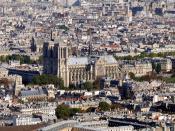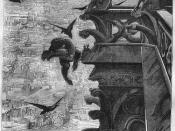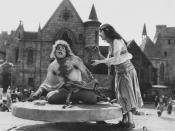Analysis
Notre-Dame de Paris:
The significant theme of fate in "Notre-Dame de Paris" is strongly ennumerated in several ways: the general trend towards fatalism in plot and character (especially Frollo) and the motif of the fly in the spider web, strongly smelling of fate, but moreso interpereted as the fly caught on a journey towards a light, or freedom. This image so skillfully displays in the truest Hugoesque style this particular struggle of man, desperately battling against the three strongest problems(as I think he discussed in the introduction to "Les Travaillers de la Mer"["The Toilers of the Sea"]) which are superstition (namely of the church), misery placed upon man by society, and the helplessness of man before nature.
Another significant motif is that of stone and upturned pavement. Quasimodo is frequently compared to his stone gargoyle companions and architectural terms are used in his descriptions (spiral legs, and a dome on his back, also more relating him to the cathedral), and Frollo is shown as an animated statue.
Upturned pavement and stone in general was a powerful symbol in Hugo's mind for the process of change, and that grand efficy that change leaves behind. Hugo could not escape the idea of revolt, hence the thieves storming Notre-Dame.
And this brings us to a phenomenally important idea not only in "Notre-Dame de Paris" but all of Hugo's works, even the more obscure ones; that is to say, the process, need, and result of change. Hugo felt a great affinity for the ocean, and, itself being a grand redeemer of change, would perhaps illustrate my point most clearly. From its depths, life springs forth; the ocean is mother to life on Earth, but contrastly its ebb and flow, its rushing torrents and massive waves, its great salt...


